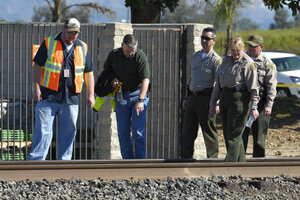Metrolink train crash: why rail safety remains elusive
Some 50 people were injured Tuesday when a Los Angeles-bound commuter train crashed into a truck stalled on the tracks. Technology investments have brought significant safety improvements, but have not entirely eliminated risk.

Officials examine the tracks near where a Metrolink train hit a truck and then derailed Tuesday, in Oxnard, Calif. Three cars of the Metrolink train tumbled onto their sides, injuring dozens of people.
Mark J. Terrill/AP
Los Angeles
The collision of a Los Angeles-bound Metrolink train after the state invested $500 million in efforts to improve rail safety has raised questions about why rail safety remains elusive despite technological advances.
The accident occurred Tuesday shortly before 6 a.m. The train derailed after crashing into a truck that was stalled on the tracks about 60 miles north of the city. Some 50 people were injured in the crash. The driver of the truck was unharmed.
The National Transportation Safety Board and Federal Railroad Administration will conduct concurrent investigations into events leading up to the crash, according to FRA spokesman Mike England.
"Safety must be every railroad's absolute top priority and we will establish what lapses, if any, occurred and order any necessary corrective actions," the NTSB said in a statement Tuesday.
The state of California attempted to address rail safety directly following two deadly accidents in southern California. In 2005, 11 people were killed and 180 others injured after a commuter train crashed into an SUV on the track, causing the train to derail and collide with a freight train in Glendale. Then, three years later, a Metrolink train collided head on with a freight train, killing 25 people and injuring 135.
In the wake of the 2005 crash, the Southern California Regional Rail Authority launched a myriad of projects designed to improve grade crossings, to build safer cars and locomotives, and to use automatic train stops and onboard rail video cameras.
In Tuesday's crash, the cab and three of the four passenger cars involved were equipped with "crash energy management" technology, which helped to disperse the energy created by the impact and probably helped to save lives.
Still, Tuesday’s accident – the third train wreck in the United States in as many weeks – underscores the fact that technical upgrades alone cannot prevent accidents, safety experts say.
“Coming close on the heels of another high-profile vehicle-commuter train crossing crash, this incident points out the importance of never being complacent when approaching train tracks – always expect a train,” says Carol Steckbeck, media consultant for Operation Lifesaver, which focuses specifically on railroad crossing safety.
“People need to take responsibility for their own personal safety,” adds Virginia Miller, spokeswoman for the American Public Transportation Association, a transportation advocacy organization based in Washington, D.C.
Both are taking the incident as a teachable moment for the public.
“Trains cannot stop on a dime and so people need to realize that they are also a piece of the safety equation,” Ms. Miller says.
That said, safety statistics nationwide have been dramatically improving nationwide for the past 20 years, she notes.
Collisions at crossings have dropped by 85 percent – from a high of more than 13,500 in 1978 to just over 2,000 in 2011, according to the FRA. The agency attributes the dramatic decrease to engineering improvements, better enforcement of traffic safety laws, and education of motorists. It estimates that 94 percent of grade crossing collisions and 87 percent of fatalities are the result of risky behavior by drivers or poor judgment.
For perspective, here are several statistics:
- Of the roughly 2,000 crossing collisions in 2013, nearly half (970) involved passenger vehicles, and 16 percent (336) involved tractor-trailers, according to Operation Lifesaver.
- 95 percent of rail-related deaths are due to crossing collisions or pedestrian trespass incidents, according to the FRA.
- While crossing collisions have plummeted since the 1970s, there has been an uptick in the past year, according to the FRA.
California is currently second in the nation for railroad crossing incidents.
“Overall, California infrastructure is in poor shape. Roads are rough, bridges are rusty, and railroads have too many grade crossings,” says Jack Pitney, a professor of government at Claremont McKenna College in Claremont, Calif.
California, he notes, has just embarked on a multi-year, multibillion-dollar bullet train whose funding will supersede such needed upgrades.
“Instead of spending billions on a high-speed rail project that we don't need, we should put some of that money toward upgrading the infrastructure that we already have,” Professor Pitney says. That could include taking car traffic under the tracks wherever possible, which would eliminate the possibility of drivers trying to speed around dropping railroad barriers.
Nationally, there are 228,000 railway crossings, nearly 140,000 on publicly owned roads. About 53 percent of the public ones have active warning devices.

